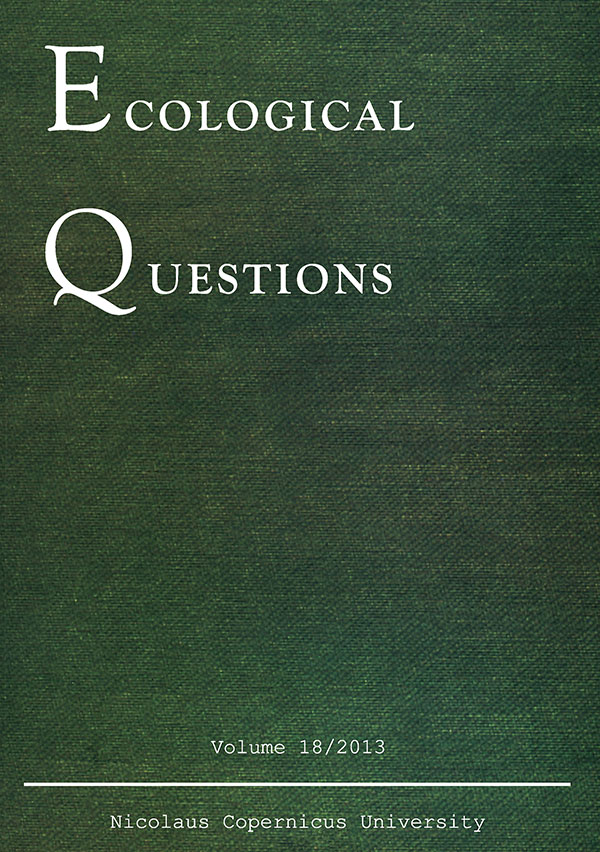Preliminary ecology research on Epipactis atrorubens (Hoffm.) Besser on the Słowińskie Coast (Northern Poland)
DOI:
https://doi.org/10.12775/ecoq-2013-0002Keywords
Orchidaceae, Epipactis atrorubens, morfological characteristics, biometry, coastal grey dunes, Helichryso–Jasionetum litoralis, soil propertiesAbstract
The research covered three stands of Epipactis atrorubens on the Słowińskie Coast (Rowy, Wicko Morskie and Jarosławiec). The plants in blossom were characterized on the basis of seven individual characteristics: height, the number of leaves, the number of flowers per inflorescence, the length and width of the largest leaf and stipule. Statistically significant differences were found in the studied populations between the height of the plant and the width of the largest leaf, the number of flowers per inflorescence and the inflorescence length up to the bract, as well as between the number of flowers per inflorescence and the inflorescence length up to the bract. The populations of E. atrorubens on the Słowińskie Coast cover the mineral soil with the dominance of medium- and fine sand fractions. Those soils are loose with very low water capacity and good permeability. The organic matter content varied from 0.4 to 0.8%. The soil reaction is low acid or close to alkaline. The analyzed soil samples were characterized by very low content of exchangeable Al3+ ions, which results from relatively high pH levels. The soil salinity was low and the average content of NaCl was between 0.146 and 0.181 g·dm-3.References
Antkowiak W. & Pankros J., 2000, Charakterystyka ekologiczna populacji kruszczyka błotnego (Epipactis palustris (L.) Crantz) z Wielkopolskiego Parku Narodowego [Occurrence and ecological conditions of Epipactis palustris (L.) Crantz) from Wielkopolski National Park], Roczniki Akademii Rolniczej w Poznaniu – CCCXXII, Bot. 3: 3-11.
Bednarek R., Dziadowiec H., Pokojska U. & Prusinkiewicz Z., 2004, Badania ekologiczno-gleboznawcze [Research of soil and ecological], Wyd. Nauk. PWN, Warszawa.
Braun-Blanquet J., 1964, Pflanzensoziologie: Grundzüge der Vegetationkunde, Springer-Verlag, Wien, New York.
Braun M., 2010, Nadmorskie wydmy szare Helichryso-Jasionetum litoralis [Coastal dunes grey Helichryso-Jasionetum litoralis], [in]: W. Mróz (ed.), Monitoring siedlisk przyrodniczych. Przewodnik metodyczny, część I [Monitoring of habitats. Methodical Guide, Part I], Biblioteka Monitoringu Środowiska, Warszawa: 61-72.
Brzosko E., Tałataj I. & Wróblewska A., 2006, Genetic structure of rare Epipactis atrorubens populations from two National Parks of northeast Poland, Polish Botanical Studies 22: 1-10.
Golis A. & Bednorz L., 2001, Charakterystyka populacji kruszczyka błotnego Epipactis palustris (Will.) Cr. w Rezerwacie Przyrody „Mielno” koło Konina [Occurrence and ecological conditions of Epipactis palustris (Will.) Cr. in the nature reserve “Mielno” near Konin], Roczniki Akademii Rolniczej w Poznaniu – CCCXXXIV, Bot. 4: 71-81.
Gworek B., 2006, Glin w środowisku przyrodniczym a jego toksyczność [Aluminium in the natural environment and his toxicity], Ochrona Środowiska i Zasobów Naturalnych 29: 27-38.
Jakubska-Busse A., 2009, Storczyki – piękno i tajemnica natury [Orchises – the beauty and the mysteries of nature], Polski Klub Ekologiczny, Dwumiesięcznik Okręgu Dolnośląskiego Zielona Planeta 1 (82)/2009: 19-21.
Jurkiewicz A., Turnau K., Mesjasz – Przybyłowicz J., Przybyłowicz W. & Godzik B., 2001, Heavy metal localisation in mycorrhizas of Epipactis atrorubens (Hoffm.) Besser (Orchidaceae) from zinc mine tailings, Protoplasma 218: 117-124.
Karczewska A. & Kabała C., 2008, Metodyka analiz laboratoryjnych gleb i roślin, wyd. 4 [Methodology of laboratory analyses of the soil and plants, 4th edition], Uniwersytet Przyrodniczy we Wrocławiu, Wrocław.
Kolon K., Krawczyk J. & Krawczyk A., 1995, Charakterystyka ekologiczna populacji Epipactis palustris (L.) Crantz znad jeziora Pomorze w Puszczy Augustowskiej [Occurrence and ecological conditions of Epipactis palustris (L.) Crantz) from Pomorze Lake in Augustowska Forest], Acta Universitatis Wratislaviensis No 1717, Prace Bot. LXIII, Wyd. Uniwersytetu Wrocławskiego, Wrocław.
Kull T. & Hutchings M. J., 2006, A comparative analysis of decline in the distribution ranges of orchid species in Estonia and the United Kingdom, Biological Conservation 129: 31–39. DOI: 10.1016/j.biocon.2005.09.046
Łukasiewicz A., 1962, Morfologiczno-rozwojowe typy bylin [Morphologic development types of perennials], Prace Kom. Biol. PTPN, 27(1): 3-397.
Ochyra R., Żarnowiec J. & Bednarek-Ochyra H., 2003, Census catalogue of Polish mosses [Katalog mchów Polski], Polish Academy of Sciences, Institute of Botany, Kraków.
Ostrowska A., Gawliński S. & Szczubiałka Z., 1991, Metody analizy i oceny właściwości gleb i roślin [Methods of analysis and evaluation of soil properties and plants], Katalog, Instytut Ochrony Środowiska, Warszawa.
Ostrowska A. & Porębska G., 2002, Skład chemiczny roślin, jego interpretacja i wykorzystanie w ochronie środowiska [The chemical composition of plants, his interpretation and the application in the environmental protection], Monografia, Inst. Ochr. Środ.,Warszawa.
Matuszkiewicz W., 2008, Przewodnik do oznaczania zbiorowisk roślinnych Polski [Guide to identification of plant communities of Poland], Wyd. PWN, Warszawa.
Mirek Z., Piękoś-Mirkowska H., Zając A. & Zając M., 2002, Flowering plants and pteridophytes of Poland – a checklist [Krytyczna lista roślin naczyniowych Polski], W. Szafer Institute of Botany, Polish Academy of Sciences, Kraków.
Sarosiek J., Krukowski-Zdanowicz J. & Woroniecka G., 1990, The ecological organization of Epipactis palustris (Mill.) Cr. population in Augustów Forest, [in:] J. Sarosiek (ed.) Proceedings of the Symposium on Biology and Ecology of European Orchids, Held at Wrocław University, Karpacz, May 30-June 3, 1985.
Szlachetko D. L., 2001, Storczyki [Orchids], Multico Oficyna Wydawnicza, Warszawa. Szweykowska A. & Szweykowski J., 2006, Botanika. Systematyka [Botany. Systematics], PWN, Warszawa.
Tałataj I. & Brzosko E., 2008, Selfing potential in Epipactis palustris, E. helleborine and E. atrorubens (Orchidaceae), Plant Systematics and Evolution 276: 21-29.
Tsiftsis S., Tsiripidis I., Karagiannakidou V. & Alifragis D., 2008, Niche analysis and conservation of the orchids of east Macedonia (NE Greece), Acta Oecologica 33: 27-35. DOI: 10.1016/j.actao.2007.08.001
Tuulik T., 1998, Hiiumaa orhideed. Biosfääri Kaitseala Himiumaa Keskus, Pirrujaak 5: 1- 134.
Vakhrameeva M. G., Tatarenko I. V., Varlygina T. I., Torosyan G. K. & Zagulskii M. N., 2008, Orchids of Russia and adjacent countries (within the borders of the former USSR), A. R.G. Gantner Verlang K. G., Ruggell/ Liechtenstein.
Wołek J., 2006, Wprowadzenie do statystyki dla biologów [Leading into statistics for biologists], Akad. Przyr., Kraków.
Downloads
Published
How to Cite
Issue
Section
Stats
Number of views and downloads: 789
Number of citations: 0



